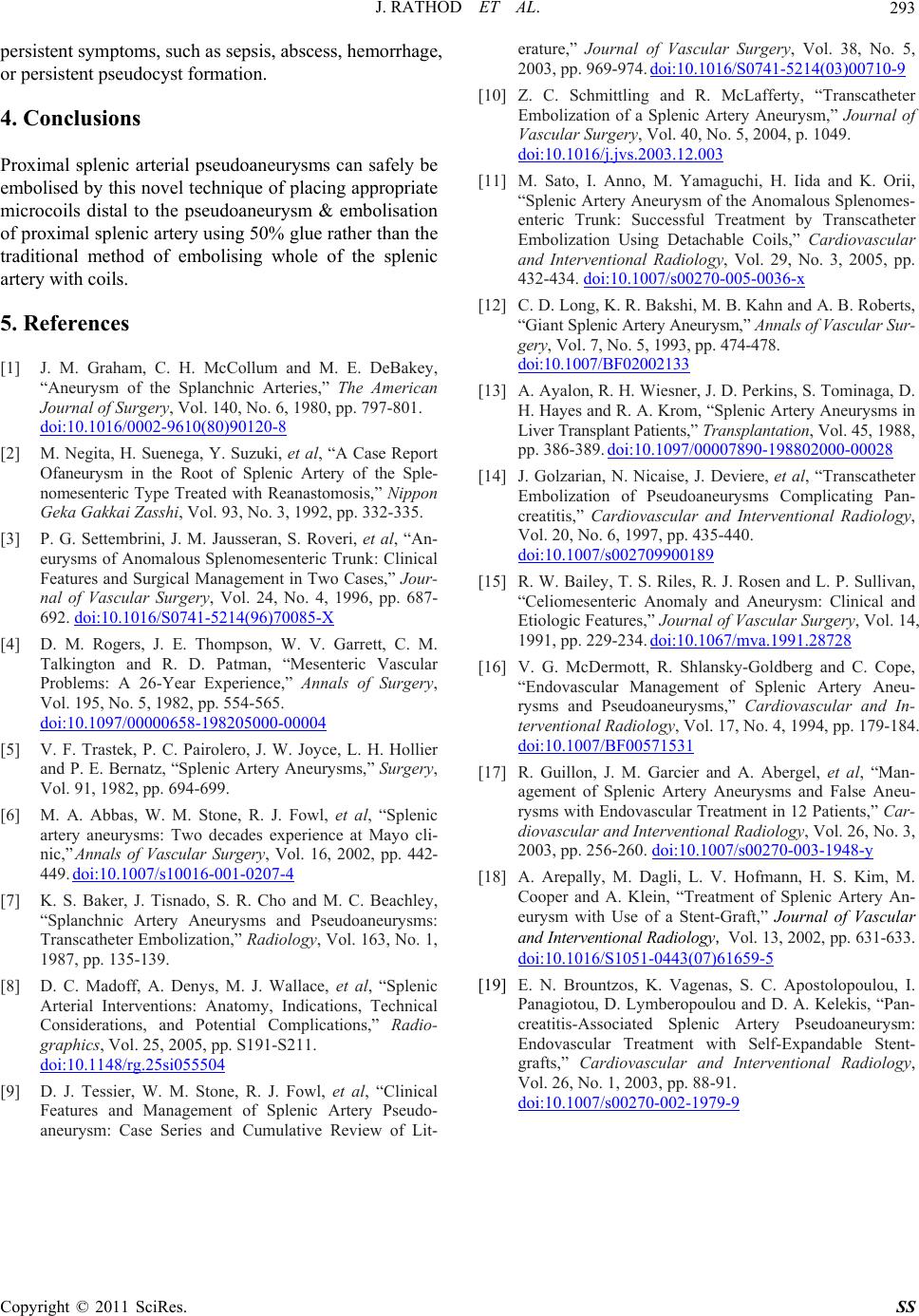
J. RATHOD ET AL.
Copyright © 2011 SciRes. SS
293
persistent symptoms, such as sepsis, abscess, h e morrhag e,
or persistent pseudocyst formation.
4. Conclusions
Proximal splenic arterial pseudoaneurysms can safely be
embolised by this novel technique of placing appropriate
microcoils distal to the pseudoaneurysm & embolisation
of proximal splenic artery using 50% glue rather than the
traditional method of embolising whole of the splenic
artery with coils.
5. References
[1] J. M. Graham, C. H. McCollum and M. E. DeBakey,
“Aneurysm of the Splanchnic Arteries,” The American
Journal of Surgery, Vol. 140, No. 6, 1980, pp. 797-801.
doi:10.1016/0002-9610(80)90120-8
[2] M. Negita, H. Suenega, Y. Suzuki, et al, “A Case Report
Ofaneurysm in the Root of Splenic Artery of the Sple-
nomesenteric Type Treated with Reanastomosis,” Nippon
Geka Gakkai Zasshi, Vol. 93, No. 3, 1992, pp. 332-335.
[3] P. G. Settembrini, J. M. Jausseran, S. Roveri, et al, “An-
eurysms of Anomalous Splenomesenteric Trunk: Clinical
Features and Surgical Management in Two Cases,” Jour-
nal of Vascular Surgery, Vol. 24, No. 4, 1996, pp. 687-
692. doi:10.1016/S0741-5214(96)70085-X
[4] D. M. Rogers, J. E. Thompson, W. V. Garrett, C. M.
Talkington and R. D. Patman, “Mesenteric Vascular
Problems: A 26-Year Experience,” Annals of Surgery,
Vol. 195, No. 5, 1982, pp. 554-565.
doi:10.1097/00000658-198205000-00004
[5] V. F. Trastek, P. C. Pairolero, J. W. Joyce, L. H. Hollier
and P. E. Bernatz, “Splenic Artery Aneurysms,” Surgery,
Vol. 91, 1982, pp. 694-699.
[6] M. A. Abbas, W. M. Stone, R. J. Fowl, et al, “Splenic
artery aneurysms: Two decades experience at Mayo cli-
nic,” Annals of Vascular Surgery, Vol. 16, 2002, pp. 442-
449. doi:10.1007/s10016-001-0207-4
[7] K. S. Baker, J. Tisnado, S. R. Cho and M. C. Beachley,
“Splanchnic Artery Aneurysms and Pseudoaneurysms:
Transcatheter Embolization,” Radiology, Vol. 163, No. 1,
1987, pp. 135-139.
[8] D. C. Madoff, A. Denys, M. J. Wallace, et al, “Splenic
Arterial Interventions: Anatomy, Indications, Technical
Considerations, and Potential Complications,” Radio-
graphics, Vol. 25, 2005, pp. S191-S211.
doi:10.1148/rg.25si055504
[9] D. J. Tessier, W. M. Stone, R. J. Fowl, et al, “Clinical
Features and Management of Splenic Artery Pseudo-
aneurysm: Case Series and Cumulative Review of Lit-
erature,” Journal of Vascular Surgery, Vol. 38, No. 5,
2003, pp. 969-974. doi:10.1016/S0741-5214(03)00710-9
[10] Z. C. Schmittling and R. McLafferty, “Transcatheter
Embolization of a Splenic Artery Aneurysm,” Journal of
Vascular Surgery, Vol. 40, No. 5, 2004, p. 1049.
doi:10.1016/j.jvs.2003.12.003
[11] M. Sato, I. Anno, M. Yamaguchi, H. Iida and K. Orii,
“Splenic Artery Aneurysm of the Anomalous Splenomes-
enteric Trunk: Successful Treatment by Transcatheter
Embolization Using Detachable Coils,” Cardiovascular
and Interventional Radiology, Vol. 29, No. 3, 2005, pp.
432-434. doi:10.1007/s00270-005-0036-x
[12] C. D. Long, K. R. Bakshi, M. B. Kahn and A. B. Roberts,
“Giant Splenic Artery Aneurysm,” Annals of Vascular Sur-
gery, Vol . 7, No. 5, 1993, pp. 474-478.
doi:10.1007/BF02002133
[13] A. Ayalon, R. H. Wiesner, J. D. Perkins, S. Tominaga, D.
H. Hayes and R. A. Krom, “Splenic Artery Ane urysms in
Liver Transplant Patients,” Transplantation, Vol. 45, 1988,
pp. 386-389. doi:10.1097/00007890-198802000-00028
[14] J. Golzarian, N. Nicaise, J. Deviere, et al, “Transcatheter
Embolization of Pseudoaneurysms Complicating Pan-
creatitis,” Cardiovascular and Interventional Radiology,
Vol. 20, No. 6, 1997, pp. 435-440.
doi:10.1007/s002709900189
[15] R. W. Bailey, T. S. Riles, R. J. Rosen and L. P. Sullivan,
“Celiomesenteric Anomaly and Aneurysm: Clinical and
Etiologic Features,” Journal of Vascular Surgery, Vol. 14,
1991, pp. 229-234. doi:10.1067/mva.1991.28728
[16] V. G. McDermott, R. Shlansky-Goldberg and C. Cope,
“Endovascular Management of Splenic Artery Aneu-
rysms and Pseudoaneurysms,” Cardiovascular and In-
terventional Ra diology, Vol. 17, No. 4, 1994, pp. 179-184.
doi:10.1007/BF00571531
[17] R. Guillon, J. M. Garcier and A. Abergel, et al, “Man-
agement of Splenic Artery Aneurysms and False Aneu-
rysms with Endovascular Treatment in 12 Patients,” Car-
diovascular and Interventional Radiology, Vol. 26, No. 3,
2003, pp. 256-260. doi:10.1007/s00270-003-1948-y
[18] A. Arepally, M. Dagli, L. V. Hofmann, H. S. Kim, M.
Cooper and A. Klein, “Treatment of Splenic Artery An-
eurysm with Use of a Stent-Graft,” Journal of Vascular
and Interventional Radiology , Vol. 13, 2002, pp. 631-633.
doi:10.1016/S1051-0443(07)61659-5
[19] E. N. Brountzos, K. Vagenas, S. C. Apostolopoulou, I.
Panagiotou, D. Lymberopoulou and D. A. Kelekis, “Pan-
creatitis-Associated Splenic Artery Pseudoaneurysm:
Endovascular Treatment with Self-Expandable Stent-
grafts,” Cardiovascular and Interventional Radiology,
Vol. 26, No. 1, 2003, pp. 88-91.
doi:10.1007/s00270-002-1979-9